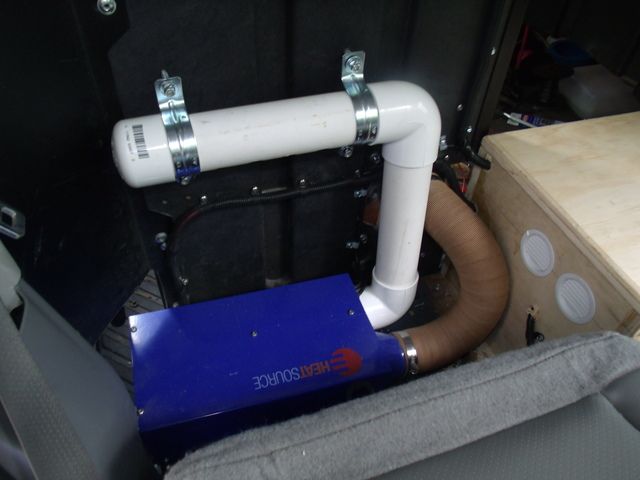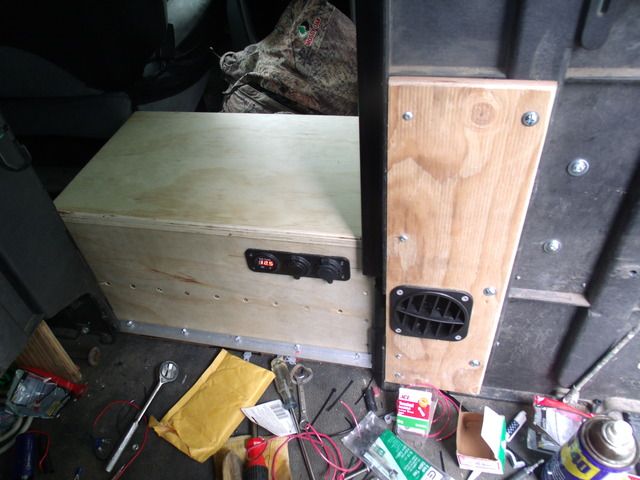Try our solar cost and savings calculator
Charging /flooded lead acid battery off of a solar panel/ sealed AGM system.
Collapse
X
-
Going on 8yrs now. The system has been flawless. I think I'm starting to see some deterioration of the second set of batteries the float is at 13.1v and when it gets dark the voltage drops to 12.7/8v it used to stay at 12.9-13v. The rig sits in the sun hAlf the day in southern NM. Is it.time to replace the batteries ? It still runs the furnace through the night but by morning it's down to 12.2v. -
4 1/2 yr up date, the system is working perfect, I've been camping, hunting and fishing all over and the system has worked without a flaw. I did change out the batteries after 3 yrs as they were starting to deplete quicker, I use them for working on outboard/boat e-systems as they are easy to move around. Best investment I've made for the van.
In the mountains near Ely NV spend the month of OCT. camping in NV and UT
6jCJoQ.jpgLast edited by AWS; 05-12-2021, 09:45 PM.Leave a comment:
-
I added a isolator and moved the wiring and installed a 100w solar panel. We are done with duck hunting season and it has been fantastic, warm all night and I don't have to look for an outlet for heat. Just this season saved me enough on campground fees for the season to pay for the system. Plus most of the landings I can camp on overnight so saves me a lot of travel time. the one great benefit is that I can head for the landing the night before and sleep in in the morning and not have to get up at dark-thirty and drive a few hours to get to the landing on time. I've only had to use the truck alternator a few times to charge the batteries.Leave a comment:
-
In the future, you may want to look at an isolator like the CTEK D250S dual.
It could simplify things, but glad your system seems to be working!
Leave a comment:
-
Leave a comment:
-
Thanks Littleharbor, that is an easy fix to move the wiring on the +load to the charging terminal.
As for the batteries gassing off, they are sealed AGM and according to the manufacture that is not a problem.
I'm trying to keep this as compact as possible and be able to move the whole unit to another vehicle in the future if needed.
The furnace only consumes 1.4 ah while running and is on a thermostat so shouldn't run continuously through the night unless extremely cold (well below zero).Leave a comment:
-
In the future you should replace those 12 volt batteries with 2 series wired 6 volt golf cart batteries. In the meantime your positive charging line and load should both be on the same diagonal corner from the negative line and load, forcing somewhat equal charge/discharge from both batteries.Last edited by littleharbor; 07-13-2016, 08:51 AM.Leave a comment:
-
I would take the wiring OUT of the battery box. If you charge with enough amps to bubble the electrolyte, acid fumes will destroy the wiring parts (fuse holders etc.)Leave a comment:
-
Project completed.
Finished the project a couple of days ago and have been testing it. I think I have a winner. I can run the Fantastic Roof vent fan for over 10 hours and not even use half the batteries power. I ran them down to nearly depleted 11.8v and charged them completely by the time I got to town (16 miles). The battery isolator keeps the starting battery full first the automatically starts to charge the cabin batteries and when the engine is shut down it isolates the two systems so running the furnace and cabin lights or roof vent won't discharge the starting battery. I will be adding a port to be able to add a portable 100w. solar panel for extended stays at remote sights.
Heater installation the white pipe is the cold air return, I raised it off the floor to eliminate picking up debris, the brown tube is the heat duct to the cabin. The wood box is the battery and wiring box.

The battery box and wiring, I left enough room for another battery if needed.

View from the cabin, heat outlet into the cabin, battery box with v. gauge and charging ports.

I did add two LED interior cabin lights also.
If you spot anything that might be amiss with the installation shout it out.Last edited by AWS; 05-12-2021, 09:46 PM.Leave a comment:
-
Our old camper is what referring to. It came with a single 100 watt panel installed by the previous owner and a single group 24 dual purpose battery. It inspired us to put new solar on our next camper which is the 280 watts I'm now running with 2 GC 6V batteries.Leave a comment:
-
You have 280 watt panel, not 100 watts. A 100 watt panel generates 5.5 amps of current. With a 4 Sun Hour day on paper generates 22 AH. But that assumes optimum orientation, tilt angle, no shade, and does not account for charge efficiency. 10 to 15 AH at best. If you use a MPPT controller you can get a little more of 30% and get up to 20 AH.In RV circles, using your vehicle to charge your battery is often considered the last resort. Firing up your 200+ horsepower engine to use as a battery charger is hardly the most economical way to do it. But when in a pinch, you do what you need to do. Your alternator can indeed make a lot of amps but it needs to try and push it through what is likely no bigger than 10 gauge wiring over a relatively long wire length. Folks that want to rely on their alternator for fast charging will upgrade the wiring to something much bigger to make better use of it.
Depending on just how much furnace use you'll have in one night, I would not count on more than one night with your single 70 ah battery. A furnace fan draws around 7 A DC. Your 100 watt panel will definitely help though, and I if it is in the sun for most of the day you'll get more than 10 ah put back in. Our old camper had a similar setup and we could easily go for 4-day weekends with no battery issues. Always furnace at night in Montana mountains and the panel was mounted fixed and flat on the roof.
I agree with you if you are parked for several days, running the engine at idle is not the best solution. That is why any off-gridder needs a generator. But when you are driving, nothing better or faster than an Electronic Isolator. Just 15 minutes does more than a week of solar panels.Leave a comment:
-
In RV circles, using your vehicle to charge your battery is often considered the last resort. Firing up your 200+ horsepower engine to use as a battery charger is hardly the most economical way to do it. But when in a pinch, you do what you need to do. Your alternator can indeed make a lot of amps but it needs to try and push it through what is likely no bigger than 10 gauge wiring over a relatively long wire length. Folks that want to rely on their alternator for fast charging will upgrade the wiring between the alternator and trailer wire harness to something much bigger to make better use of it.
Depending on just how much furnace use you'll have in one night, I would not count on more than one night with your single 70 ah battery. A furnace fan draws around 7 A DC. Your 100 watt panel will definitely help though, and I if it is in the sun for most of the day you'll get more than 10 ah put back in. Our old camper had a similar setup and we could easily go for 4-day weekends with no battery issues. Always furnace at night in Montana mountains and the panel was mounted fixed and flat on the roof.Last edited by ewarnerusa; 05-31-2016, 03:24 PM.Leave a comment:
-
I guess I'll find out. I'm going to set it up with the battery Isolator, according to the furnace manufacturer I should get three nights of heat with a 70 ah battery. We are going to buy a 100w. portable solar panel for my wife's Pleasure Way so I'll borrow it if it looks like I will be stationary for a longer period of time.
Thank you for all the helpLeave a comment:
-
I got a better question and answer for you.
How long would it take 100 watt panel mounted flat on top of your van? .
At best you may replace 10 AH per day, so 3 to 4 days with a panel assuming absolutely no clouds or any kind of shade from sunrise to sunset.
Alternator depends on size and what is running at the time, but 30 minutes to 2 hours.
Leave a comment:
-
The battery generally is ok in an automotive system, as it's always nearly full, and doesn't pull much from the alternator. But when you have a discharged battery, it can really stress the alternator while charging, You may have to get a fancy Controller or Isolator. Balmar makes some
Leave a comment:
Copyright © 2014 SolarReviews All rights reserved.
Powered by vBulletin® Version 6.1.3
Copyright © 2025 MH Sub I, LLC dba vBulletin. All rights reserved.
Copyright © 2025 MH Sub I, LLC dba vBulletin. All rights reserved.
All times are GMT-5. This page was generated at 08:27 PM.


Leave a comment: